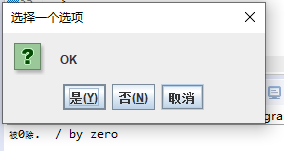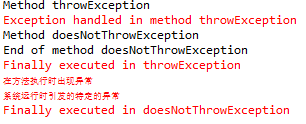一、
package test; import javax.swing.*; public class AboutException { public static void main(String[] a) { int i=1, j=0, k; // k=i/j; try { k = i/j; // Causes division-by-zero exception //throw new Exception("Hello.Exception!"); } catch ( ArithmeticException e) { System.out.println("被0除. "+ e.getMessage()); } catch (Exception e) { if (e instanceof ArithmeticException) System.out.println("被0除"); else { System.out.println(e.getMessage()); } } finally { JOptionPane.showConfirmDialog(null,"OK"); } } }

把可能会发生错误的代码放进try语句块中。
当程序检测到出现了一个错误时会抛出一个异常对象。异常处理代码会捕获并处理这个错误。 catch语句块中的代码用于处理错误。
当异常发生时,程序控制流程由try语句块跳转到catch语句块。
不管是否有异常发生,finally语句块中的语句始终保证被执行。
如果没有提供合适的异常处理代码,JVM将会结束掉整个应用程序。
二、
package test; public class CatchWho { public static void main(String[] args) { try { try { throw new ArrayIndexOutOfBoundsException(); } catch(ArrayIndexOutOfBoundsException e) { System.out.println( "ArrayIndexOutOfBoundsException" + "/内层try-catch"); } throw new ArithmeticException(); } catch(ArithmeticException e) { System.out.println("发生ArithmeticException"); } catch(ArrayIndexOutOfBoundsException e) { System.out.println( "ArrayIndexOutOfBoundsException" + "/外层try-catch"); } } }

三、
package test; public class CatchWho2 { public static void main(String[] args) { try { try { throw new ArrayIndexOutOfBoundsException(); } catch(ArithmeticException e) { System.out.println( "ArrayIndexOutOfBoundsException" + "/内层try-catch"); } throw new ArithmeticException(); } catch(ArithmeticException e) { System.out.println("发生ArithmeticException"); } catch(ArrayIndexOutOfBoundsException e) { System.out.println( "ArrayIndexOutOfBoundsException" + "/外层try-catch"); } } }

四、
package test; public class EmbededFinally { public static void main(String args[]) { int result; try { System.out.println("in Level 1"); try { System.out.println("in Level 2"); // result=100/0; //Level 2 try { System.out.println("in Level 3"); result=100/0; //Level 3 } catch (Exception e) { System.out.println("Level 3:" + e.getClass().toString()); } finally { System.out.println("In Level 3 finally"); } // result=100/0; //Level 2 } catch (Exception e) { System.out.println("Level 2:" + e.getClass().toString()); } finally { System.out.println("In Level 2 finally"); } // result = 100 / 0; //level 1 } catch (Exception e) { System.out.println("Level 1:" + e.getClass().toString()); } finally { System.out.println("In Level 1 finally"); } } }

当有多层嵌套的finally时,异常在不同的层次抛出 ,在不同的位置抛出,可能会导致不同的finally语句块执行顺序。
五、辨析:finally语句块一定会执行吗?
package test; public class SystemExitAndFinally { public static void main(String[] args) { try{ System.out.println("in main"); throw new Exception("Exception is thrown in main"); //System.exit(0); } catch(Exception e) { System.out.println(e.getMessage()); System.exit(0); } finally { System.out.println("in finally"); } } }

不一定。
六、如何跟踪异常的传播路径?
package test; //UsingExceptions.java //Demonstrating the getMessage and printStackTrace //methods inherited into all exception classes. public class PrintExceptionStack { public static void main( String args[] ) { try { method1(); } catch ( Exception e ) { System.err.println( e.getMessage() + "\n" ); e.printStackTrace(); } } public static void method1() throws Exception { method2(); } public static void method2() throws Exception { method3(); } public static void method3() throws Exception { throw new Exception( "Exception thrown in method3" ); } }

当程序中出现异常时,JVM会依据方法调用顺序依次查找有关的错误处理程序。
可使用printStackTrace 和 getMessage方法了解异常发生的情况:
printStackTrace:打印方法调用堆栈。
每个Throwable类的对象都有一个getMessage方法,它返回一个字串,这个字串是在Exception构造函数中传入的,通常让这一字串包含特定异常的相关信息。
七、抛出多个受控异常的方法
package test; import java.io.IOException; public class ThrowMultiExceptionsDemo { public static void main(String[] args) { try { throwsTest(); } catch(IOException e) { System.out.println("捕捉异常"); } } private static void throwsTest() throws ArithmeticException,IOException { System.out.println("这只是一个测试"); // 程序处理过程假设发生异常 throw new IOException(); //throw new ArithmeticException(); } }

一个方法可以声明抛出多个异常。
当一个方法声明抛出多个异常时,在此方法调用语句处只要catch其中任何一个异常,代码就可以顺利编译。
八、子类抛出受控异常的限制
package test; import java.io.*; public class OverrideThrows { public void test()throws IOException { FileInputStream fis = new FileInputStream("a.txt"); } } class Sub extends OverrideThrows { //如果test方法声明抛出了比父类方法更大的异常,比如Exception //则代码将无法编译…… public void test() throws FileNotFoundException { //... } }
一个子类的throws子句抛出的异常,不能是其基类同名方法抛出的异常对象的父类。
九、异常处理代码模板
package example; /** * 自定义的异常类 * @author JinXuLiang * */ class MyException extends Exception { public MyException(String Message) { super(Message); } public MyException(String message, Throwable cause) { super(message, cause); } public MyException( Throwable cause) { super(cause); } } public class ExceptionLinkInRealWorld { public static void main( String args[] ) { try { throwExceptionMethod(); //有可能抛出异常的方法调用 } catch ( MyException e ) { System.err.println( e.getMessage() ); System.err.println(e.getCause().getMessage()); } catch ( Exception e ) { System.err.println( "Exception handled in main" ); } doesNotThrowException(); //不抛出异常的方法调用 } public static void throwExceptionMethod() throws MyException { try { System.out.println( "Method throwException" ); throw new Exception("系统运行时引发的特定的异常"); // 产生了一个特定的异常 } catch( Exception e ) { System.err.println( "Exception handled in method throwException" ); //转换为一个自定义异常,再抛出 throw new MyException("在方法执行时出现异常",e); } finally { System.err.println( "Finally executed in throwException" ); } // any code here would not be reached } public static void doesNotThrowException() { try { System.out.println( "Method doesNotThrowException" ); } catch( Exception e ) { System.err.println( e.toString() ); } finally { System.err.println( "Finally executed in doesNotThrowException" ); } System.out.println( "End of method doesNotThrowException" ); } }

在实际开发中,可以参照ExceptionLinkInRealWorld.java 示例的做法,定义一些与业务逻辑相关的自定义异常类,供上层代码进行捕获,从而能更精确地反映系统真实运行情况并及时进行处理。